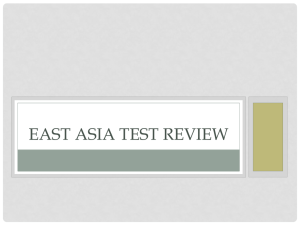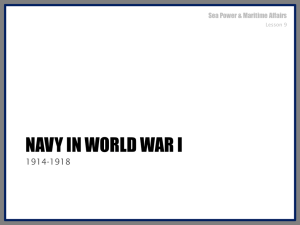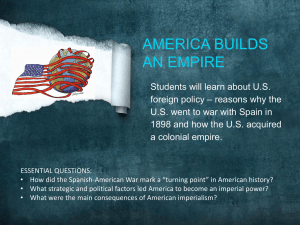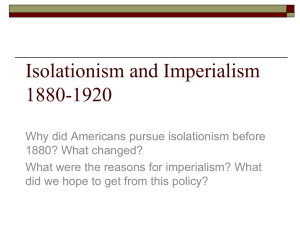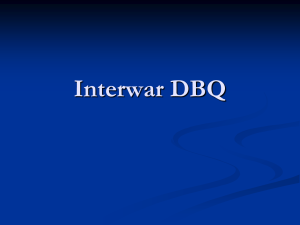21124-6
advertisement
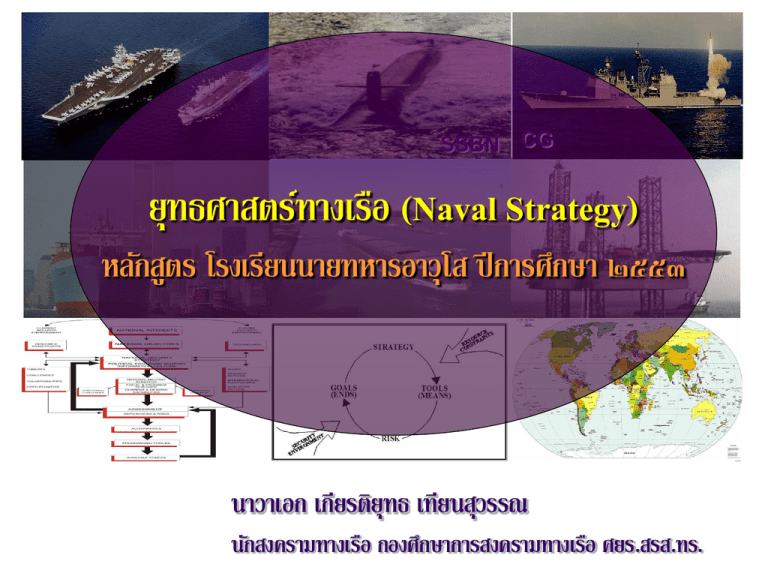
SSBN CG ยุทธศาสตร์ทางเรือ (Naval Strategy) หลักสูตร โรงเรียนนายทหารอาวุโส ปี การศึกษา ๒๕๕๓ นาวาเอก เกียรติยุทธ เทียนสุวรรณ นักสงครามทางเรือ กองศึกษาการสงครามทางเรือ ศยร.สรส.ทร. ประวัติการรับราชการ นักบินฝูงบิน ๑๐๓ กองบิน ๑ กองการบินทหารเรือ นักบินฝูงบิน ๑ หน่ วยบิน ร.ล.จักรีนฤเบศร กองเรือบรรทุกเฮลิคอปเตอร์ นายธงผูบ้ ญั ชาการกองการบินทหารเรือ นายทหารยุทธการฝูงบิน ๑ หน่ วยบิน ร.ล.จักรีนฤเบศร กองเรือบรรทุกเฮลิคอปเตอร์ ประจาแผนกข่าว กองเรือบรรทุกเฮลิคอปเตอร์ หัวหน้าพัฒนาการฝึ ก กองการฝึ กทางเรือ อาจารย์กองวิชาเสนาธิการกิจ สถาบันวิชาการทหารเรือชัน้ สูง อาจารย์กองวิชาสงครามทางเรือและวิชาทหาร สถาบันวิชาการทหารเรือชัน้ สูง นักสงครามทางเรือ กองศึกษาการสงครามทางเรือ ศูนย์ศึกษายุทธศาสตร์ทางเรือ ประวัติการฝึ ก ศึกษา อบรม หลักสูตรวิทยาศาสตร์บณ ั ฑิต โรงเรียนนายเรือ พ.ศ.๒๕๓๐-๓๕ หลักสูตรนายทหารใหม่ พ.ศ.๒๕๓๕ หลักสูตรศิษย์การบิน โรงเรียนการบินกาแพงแสน พ.ศ.๒๕๓๕-๓๖ หลักสูตรนักบินขับไล่ไอพ่น ประเทศสหรัฐอเมริกา พ.ศ.๒๕๓๗-๒๕๓๙ หลักสูตรนักบิน บ.AV-8 ประเทศสเปน พ.ศ.๒๕๓๙-๒๕๔๐ หลักสูตรการบริหารเพือ่ การป้ องกันประเทศ ประเทศออสเตรเลีย พ.ศ.๒๕๔๔ หลักสูตรโรงเรียนนายทหารพรรคนาวิน พ.ศ.๒๕๔๔ หลักสูตรศิลปศาสตร์มหาบัณฑิต (ยุทธศาสตร์และนโยบาย) ประเทศออสเตรเลีย พ.ศ.๒๔๔๕๒๕๔๖ หลักสูตรโรงเรียนเสนาธิการทหารเรือ พ.ศ.๒๕๔๗-๒๕๔๘ หลักสูตรวิทยาลัยการทัพเรือ ประเทศสหรัฐฯ พ.ศ.๒๕๔๙-๒๕๕๐ หลักสูตรการบริหารทรัพยากรเพือ่ การป้ องกันประเทศ ประเทศสหรัฐฯ พ.ศ.๒๕๕๐ ความสัมพันธ์กบั หัวข้อวิชาอืน่ ในหมวดวิชา หมวดวิชาความมัน่ คงแห่งชาติ ตอนที่ ๑ หลักยุทธศาสตร์ ชุดวิชาที่ ๑ หลักยุทธศาสตร์ ชุดวิชาที่ ๒ โครงสร้างและแนวความคิดทางยุทธศาสตร์ หัวข้อวิชา นโยบายความมัน่ คงแห่งชาติ หัวข้อวิชา ยุทธศาสตร์ทหาร หัวข้อวิชา ยุทธศาสตร์ทะเล หัวข้อวิชา ยุทธศาสตร์ทางเรือ หัวข้อวิชา สัมมนาโครงสร้างและแนวความคิดทางยุทธศาสตร์ หัวข้อวิชา สัมมนายุทธศาสตร์ทางเรือ ความมุ่งหมาย เมื่ อ จบหัว ข้อ วิ ช านี้ แล้ว นทน. สามารถที่ จ ะอธิ บ าย กรรมวิธีการกาหนดยุทธศาสตร์และแนวความคิดทาง ยุทธศาสตร์ของกองทัพเรือ อธิบายความสัมพันธ์กบั ยุทธศาสตร์ชาติ ยุทธศาสตร์ทะเล ยุทธศาสตร์ทหาร และยุทธศาสตร์ทางเรือ ลาดับการบรรยาย ความหมายของยุทธศาสตร์ทางเรือ ความสัมพันธ์ของยุทธศาสตร์ทางเรือกับยุทธศาสตร์อน่ื กระบวนการกาหนดยุทธศาสตร์ทางเรือ Planning Who am I? Where are we? Where should we go? Implementation How do we get there? Are we getting there? ความหมายของยุทธศาสตร์ทางเรือ ยุทธศาสตร์ ยุทธศาสตร์ เครื่องมือ เป้ าหมาย ความเสีย่ ง การใช้เครื่องมือที่มีอยูเ่ พือ่ ให้บรรลุเป้ าหมาย The application of available Means to secure desired Ends. ยุทธศาสตร์ชาติ ยุทธศาสตร์ชาติ วัตถุประสงค์แห่งชาติ กาลังอานาจแห่งชาติ ความเสีย่ ง การใช้กาลังอานาจแห่งชาติท่มี อี ยู่เพื่อให้บรรลุวตั ถุประสงค์แห่งชาติ The application of available Means to secure desired Ends. ยุทธศาสตร์ทะเล ยุทธศาสตร์ทะเล วัตถุประสงค์ทางทะเล สมุททานุ ภาพ ความเสีย่ ง การใช้สมุททานุ ภาพที่มีอยู่เพือ่ ให้บรรลุวตั ถุประสงค์ทางทะเล The application of available Means to secure desired Ends. ยุทธศาสตร์ทหาร ยุทธศาสตร์ทหาร วัตถุประสงค์ทางทหาร กาลังทางทหาร ความเสีย่ ง ยุทธศาสตร์ทางเรือ ยุทธศาสตร์ทางเรือ วัตถุประสงค์ทางเรือ ความเสีย่ ง กาลังทางเรือ ยุทธศาสตร์ทางเรือ? AUSTRALIAN MARITIME DOCTRINE RAN DOCTRINE 1 2000 A Cooperative Strategy for 21st Century Seapower Future Navy Vision 2006 ความสัมพันธ์ของยุทธศาสตร์ทางเรือกับยุทธศาสตร์อน่ื National Policy Land Strategy Foreign Policy Economic Policy Defence Policy Maritime Policy Military Strategy Maritime Strategy (Civil) Naval Strategy Military Operations Maritime Commerce Maritime Naval Capabilities (Military) Naval Operations Maritime Naval Capabilities (Civil) Commercial Operations Seapower Joint Operations Air Strategy การกาหนด ยุทธศาสตร์ C O N C E P T U A L F R A M E W O R K กระบวนการกาหนดยุทธศาสตร์ทางเรือ กระบวนการกาหนดยุทธศาสตร์ทางเรือ Are we getting there? How do we get there? Where should we go? Where are we? Who am I? Who am I? วัตถุประสงค์ทางทะเล • ทรัพยากร (The sea as a resource) • การขนส่งสินค้า (The sea as a medium of transportation and exchange) • ข้อมูลข่าวสาร (The sea as a medium for information and the spread of ideas) • การแผ่ขยายอานาจ (The sea as a medium for dominion) แนวโน้มพฤติกรรมของมนุษย์ ขัดแย้ง ร่วมมือ ขอบเขตความร่วมมือและขัดแย้ง Conflict Cooperation Normal Stain Crisis War บทบาททางเรือกับวัตถุประสงค์ทางทะเล ทรัพยากร MARITIME COOPERATION การขนส่งสินค้า NAVAL ROLES ข้อมูลข่าวสาร การแผ่ขยายอานาจ Building Confidence CONFLICT AND COMPETITION Winning the Battles สมุททานุภาพ การควบคุมทะเลโดยการค้า ทางทะเลและความ เหนื อ กว่า ของกาลังทางเรือทาให้เกิดอิท ธิพลใน โลกนี้ อย่างมาก...[และ] ยังเป็ นเครื่องมือหลักใน การทาให้ชาติมีความมัน่ คัง่ Control of the sea by maritime commerce and naval supremacy means predominant influence in the world …[and] is the chief among the merely material elements in the power and prosperity of nations. -Mahan- ข้อจากัดของสมุททานุภาพ ผูใ้ ดปกครองยุโรปตะวันออก จะควบคุมดินแดนหลักของ โลก ผูใ้ ดควบคุมดินแดนหลักของโลกจะควบคุมเกาะของ โลก และผูใ้ ดควบคุมเกาะของโลกจะควบคุมโลก "Who rules East Europe commands the Heartland; Who rules the Heartland commands the World Island; Who rules the World Island commands the World." -Mackinder- องค์ประกอบแห่งความสาเร็จทางทะเล การค้าทาง ทะเล ความเหนื อกว่า ทางทะเล ทรัพยากรทาง ทะเล ความเข้มแข็ง ทางเรือ กองทัพเรือแตกต่างจากกองทัพบกและกองทัพอากาศ ตรงที่ขนาดและอานาจการทาลายไม่ได้ข้ ึนอยู่กบั ศักยภาพของศัตรู แต่จะขึ้นอยู่กบั ผลประโยชน์ทางทะเลที่ประเทศชาติตอ้ งปกป้ องคุม้ ครอง Where are we? ระดับชัน้ ของกองทัพเรือ Major global force projection navy (Complete) Major global force projection navy (Partial) Medium global force projection navy Medium regional force projection navy Adjacent force projection navy Offshore territorial defence navy Inshore territorial defence navy Constabulary navy Token navy ระดับชัน้ ของกองทัพเรือ Power Group Naval Mission Capabilities Strategic Deterrence and Compellence Power Projection Sea Control Naval Diplomacy National Humanitarian Security and Assistance Constabulary Major Naval Powers Yes Yes Yes Yes Yes Yes Medium Naval Powers No Mainly Cooperative Limited Yes Yes Yes Small and Coastal State Navies No No Over Own Waters No Yes Within Own Waters ระดับชัน้ ของกองทัพเรือ • Size and Nature of the fleet • Geographic reach • Function and capability • Access to high-grade technology • Reputation • Readiness • Supply and infrastructure • Balance ระดับชัน้ ของกองทัพเรือ • Platform • Surface Ships • Submarines • Aircraft and Aircraft Carriers CG •Systems, Weapons, and Sensors • Information SSBN เทคโนโลยีทางเรือในอนาคต What should we do? สภาวะแวดล้อมทางทะเล The Sea is: Global Largely un-owned and un-ownable Three-dimensional Large, Opaque, varied and often hostile วิวฒ ั นาการของแนวคิดการปฏิบตั ิการทางเรือ Author Title of work Year Country King Alfonso of Castile Of the War that is Made on the Sea The Benefits and Principles of Oceanography Ahmad Bin Majid Book of Profitable Things Concerning Suleiman al Malin Fundamentals for the Mastery of Naval Science Antoine de Conflans On the Nature of the Fleet and Navigation Alonso de Chaves Seaman’s Glass 1270 1489 Spain UAE 1511 Oman 1516 1538 France Spain ---------------------- ------------------------------------------------------ ------ -------- Domenico Bonamico Maritime Power 1899 Italy Mahan and the Blue-Water Tendency A navy which wishes to effect decisively the issues of a maritime war must be composed of heavy ships – ‘battleships’ – possessing a maximum of fighting power, and so similar in type as to facilitate that uniformity of movement and of evolution upon which concentration … must depend. Alfred T. Mahan Mahan and the Blue-Water Tendency Command of the sea การครองทะเล ความเหนื อกว่าทางทะเล Sea dominance การมีอานาจสูงสุดทางเรือ Naval Supremacy ทะเลลึก Blue water การยุทธเชิงรุกและเชิงรับ Offensive and Decisive Battle การเคลื่อนกาลังออกไปส่วนหน้า Forward-deployed, กองทัพเรือขนาดใหญ่ท่ปี ฏิบตั กิ ารได้สามมิติ Big fleet triphibious Navy, Public and professional support. การสนับสนุ นจากมหาชน Corbett and the Maritime Tradition Of late years the world has become so deeply impressed with the efficacy of seapower that we are inclined to forget how impotent it is of itself to decide a war against great continental states, how tedious is the pressure of naval action unless it be nicely coordinated with military and diplomatic pressure. Julian S. Corbett Corbett and the Maritime Tradition Since men live upon the land and not upon the sea, great issues between nations at war have always been decided – except in the rarest cases – either by what your army can do against your enemy’s territory and national life or else by the fear of what the fleet makes it possible for your army to do. Naval Strategy has to be related to land strategy. Corbett and the Maritime Tradition Foreign policy related, Joint approach, Cost-effectiveness, Sea control, Amphibious operation, Expeditionary operation, Limited and modest objective, Projection power ashore. ความสัมพันธ์กบั นโยบายต่างประเทศ มุ่งไปสูก่ ารปฏิบตั กิ ารร่วม มุ่งเน้นประสิทธิภาพ ควบคุมทะเล ปฏิบตั กิ ารสะเทินน้ าสะเทินบก ปฏิบตั กิ ารโพ้นทะเล วัตถุประสงค์จากัด ขยายอานาจสูฝ่ งั ่ แนวคิดการปฏิบตั ิการทางเรือ การครองทะเล (Command of the Sea) การควบคุมทะเล (Sea Control) แนวคิดการปฏิบตั ิการทางเรือ 1. 2. 3. 4. 5. Absolute Control (Command of the sea) Working Control (Sea control) Control in dispute Enemy working control Enemy absolute control แนวคิดการปฏิบตั ิการทางเรือ การครองทะเล การควบคุมทะเล การปฏิเสธการใช้ทะเล (Sea Denial) แนวคิดการปฏิบตั ิการทางเรือ การครองทะเล การควบคุมทะเล การปฏิเสธการใช้ทะเล การยุทธแบบเด็ดขาด (Decisive Battle) กองเรือคงชีพ (Fleet-in-Being) การปิ ดล้อมทางเรือ (Fleet Blockade) แนวคิดการปฏิบตั ิการทางเรือ การครองทะเล การควบคุมทะเล การปฏิเสธการใช้ทะเล การยุทธแบบเด็ดขาด กองเรือคงชีพ การปิ ดล้อมทางเรือ การขยายกาลังสูฝ่ งั ่ ปฏิบตั กิ ารสะเทินน้ าสะเทินบก การโจมตีดว้ ยขีปนาวุธจากเรือ การโจมตีและปกป้ อง เส้นทางคมนาคมทางทะเล ปฏิบตั กิ ารโพ้นทะเล การทูตทางเรือ ปฏิบตั กิ ารเพื่อมนุ ษยธรรม แนวคิดการปฏิบตั ิการทางเรือ WW I Sea Control by Blockade WW II • • • Cold War Maritime Evacuation • Decisive Fleet Engagement • Amphibious Ops • Strategic SeaBased Attack Strategic SeaBased Attack Post Cold War Diplomacy and Patrol • Diplomacy • Strategic SeaBased Attack • Humanitarian Ops แนวคิดการปฏิบตั ิการทางเรือ Decisive Battle Fleet-In-Being Fleet Blockade War time Peace time Maritime Power Projection Command of the Sea Sea Control Sea Denial Military Objective Political Objective Expeditionary Operations Naval Diplomacy Humanitarian Operations Constabulary Economical Objective Defence of Shipping บทบาททางเรือกับวัตถุประสงค์ทางทะเล Resources MARITIME COOPERATION Transportation • Diplomatic Role • Economic Role • Military Role Information Dominion Building Confidence CONFLICT AND COMPETITION • Constabulary Role Winning the Battles การกาหนดยุทธศาสตร์ทางเรือ กระบวนการวางแผนยุทธศาสตร์ Strategy National Objectives • Diplomatic • Economic • Military Means Ends Risks Naval Technologies & Concept of Operations Strategy ระดับของยุทธศาสตร์ Means Ends Risks National Security Strategy Grand Strategy Strategy National Strategy Ends Strategy Means Ends Risks National Military Strategy Risks Maritime Strategy Strategy Service Strategy Ends Means Means Risks Naval Strategy Strategy แนวคิดเชิงยุทธศาสตร์ Strategic Concepts Means Ends Risks • Geography • History • Nature of Political Regime • Religion • Ideology • Culture • Political and Military Institutions • Economic and Technological Factors Strategy แนวคิดเชิงยุทธศาสตร์ Means Ends Risks ? Strategic Concepts • Geography • History • Nature of Political Regime • Religion • Ideology • Culture • Political and Military Institutions • Economic and Technological Factors Strategy แนวคิดเชิงยุทธศาสตร์ Means Ends Risks •Shape • Adapt • Reserve Strategic Concepts • Geography • History • Nature of Political Regime • Religion • Ideology • Culture • Political and Military Institutions • Economic and Technological Factors Strategy แนวคิดเชิงยุทธศาสตร์ Means Ends Risks • Primacy • Cooperative Security • Selective Engagement • Neo-Isolationism Strategic Concepts • Geography • History • Nature of Political Regime • Religion • Ideology • Culture • Political and Military Institutions • Economic and Technological Factors Strategy มหายุทธศาสตร์ของชาติ Means Ends Risks NeoIsolationism Selective Engagement Cooperative Security Primacy Regional Conflict Abstain Contain; discriminate intervention Intervene Contain; discriminate intervention Ethic Conflict Abstain Contain Nearly indiscriminate intervention Discriminate intervention Discriminate intervention Nearly indiscriminate intervention Contain Humanitarian Abstain Intervention Use of Force Self-defense Discriminate Frequent At will Force Posture Minimal selfdefense force Two-MRC force Reconnaissance strike complex for multilateral action A two-powerstandard force • Primacy • Cooperative Security • Selective Engagement • Neo-Isolationism กระบวนการวางแผนยุทธศาสตร์ Strategy National Objectives • Diplomatic • Economic • Military Means Ends Risks Naval Technologies & Concept of Operations การเปลีย่ นแปลงสภาวะแวดล้อมและยุทธศาสตร์ทางเรือ การเปลีย่ นแปลงสภาวะแวดล้อมและการกาหนดยุทธศาสตร์ทางเรือ US Maritime Strategy On offensive sea control and horizontal escalation using the USN’s command of the sea (for example, attacking the Soviet Far East if the Soviet Union had attacked Europe). The primary task was war at sea through sea control. Indeed, throughout the Cold War period, the focus of Western maritime strategy was the containment of Soviet power at sea by Western sea control (US Navy’s 1986 document Maritime Strategy) การเปลีย่ นแปลงสภาวะแวดล้อมและการกาหนดยุทธศาสตร์ทางเรือ US Maritime Strategy We are now witnessing quite radical change in the global security system…Even the continued dominance of the nation state can no longer be taken for granted, with its power apparently leaking away to supranational, transnational and sectional organizations and interests…[T]he assumptions of national statesmen are shifting too: old enemies are new friends; bipolarity has been replaced by multipolarity; order by disorder; the familiar alliance systems of the past are shifting beneath our feet. (Geoffrey Till, ‘Maritime Strategy and the Twenty-First Century’) การเปลีย่ นแปลงสภาวะแวดล้อมและการกาหนดยุทธศาสตร์ทางเรือ US Maritime Strategy The Cold War Forward Maritime Strategy which focused on deterrence, warfighting and crises-response requirement, has been replaced by the US Navy White Paper,…From the Sea-Preparing for the Naval Service for the 21st Century A Cooperative Strategy for 21st Century Seapower Objectives to secure the United States from direct attack; secure strategic access and retain global freedom of action to build confidence and trust among nations Strategic Concepts Implementing • Limit regional Conflict with forward deployed. • Deter major power war. • Win our Nation’s wars. • Contribute to homeland defense in depth. • Foster and sustain cooperative relationships with more international partners. • Prevent or contain local disruptions before they impact the global system. Expand Core Capabilities • Forward Presence. • Deterrence. • Sea Control. • Power Projection. • Maritime Security. • Humanitarian Assistance and Disaster Response. Maritime Strategy of the United states Implementing Expand Core Capabilities • Forward Presence. • Deterrence. • Sea Control. • Power Projection. • Maritime Security. • Humanitarian Assistance and Disaster Response. Implementation Priorities • Improve Integration and Interoperability. • Enhance Awareness. • Prepare Our People. Maritime Strategy of the United states การเปลีย่ นแปลงสภาวะแวดล้อมและการกาหนดยุทธศาสตร์ทางเรือ US Naval Forces Force Type 1988 1991 1993 1997 BUR QDR Decrease (%) 1. Submarines -SSN -SSBN 100 37 80 40 55 21 53 18 45-55 ? 50 ? 50 ? 2. Aircraft Carriers -CV/N V/STOL(LHA/LHD/LPN) 16 12 13 12 14 13 12 11 12 11 12 11 25 8 3.Surface Combatants 194 150 147 128 131 116 40 การเปลีย่ นแปลงสภาวะแวดล้อมและการกาหนดยุทธศาสตร์ทางเรือ Russian military doctrine Objectives: Free access to the Baltic seaports, free exits to the Baltic and Black Seas and free navigation of the World Ocean Environment: (1) the aspiration of states for world or regional hegemony; (2) the stationing of powerful armed formations near Russia’s borders to secure a military-strategic advantage; (3) the proliferation of weapons of mass destruction; (political or economic pressure on; or blackmail of Russia; and (5) violation of the rights of Russian citizens in the former Republics of the USSR Strategic Concepts: •Emphasis on homeland defence and strategic stability…close to shore for the navy. Major roles of the Pacific Fleet’s mission: • Strategic strike and deterrence; Sea control operations in the support of ballistic missile submarine force; the protection of sea-lanes of communication; and peacetime instrument of foreign policy. การเปลีย่ นแปลงสภาวะแวดล้อมและการกาหนดยุทธศาสตร์ทางเรือ Russian naval Forces in Pacific Fleet Force Type 1990 1991 1992 1993 1994 1995 1996 1997 Decrease (%) 1. Submarines 110 -SSBNs 24 -SSGNs 19 -SSNs 26 -SSs 38 3 -SSGs 98 24 18 22 31 3 87 21 15 22 27 2 66 20 9 17 20 0 51 16 4 14 17 0 54 18 5 14 17 0 43 14 6 14 9 0 51 18 5 14 17 0 54 25 74 46 55 100 2. Major Ships -CV -CC -DD -FF 63 2 14 14 40 54 1 13 7 33 49 0 14 7 28 50 0 9 6 35 49 0 9 6 34 45 0 4 7 34 49 0 9 6 34 28 100 40 14 24 69 2 15 7 45 การเปลีย่ นแปลงสภาวะแวดล้อมและการกาหนดยุทธศาสตร์ทางเรือ Chinese Naval Strategy 1960s Military Strategy: People’s war Naval Mission: to support the army in defending the land and sea approaches Naval Strategy: Coastal defence 1980s Military Strategy: People’s war under modern conditions focused on; - small-scale conflicts restricted to contested border territory; - conflict over territorial sea and islands; Naval Strategy: Offshore defence Since the late 1980s, navy planers have called for changing from a coastal defence strategy to an offshore defence strategy, which would extend the defence perimeter to between 200nm and 400nm from the coast, and even more in the case of the South China Sea islands. The navy hopes to have a so-called offshore navy on patrol by the year 2000 and a blue-water navy operating by 2050. Strategy การจัดการความเสีย่ ง Ends Means Risks Strategic military risk Operational risk Force Performance Force Preparation risk Force Sustainability Transformation Affordability risk Internal Hedging External Strategy การจัดการความเสีย่ ง 1 Develop force options 3 Determine risk metrics and levels 4 Model and assess Force performance 5 Assess risk: acceptable? Revisit strategy Force sustainability Revisit force options Preparation for future Affordability analysis Risks Means Risks NO Develop strategy-driven prioritization of force requirement 2 Ends Assessment YES complete • Primacy • Cooperative Security • Selective Engagement • Neo-Isolationism กระบวนการวางแผนยุทธศาสตร์ Strategy National Objectives • Diplomatic • Economic • Military Means Ends Risks Naval Technologies & Concept of Operations Strategy ข้อจากัดของทรัพยากร Ends Means Risks Population, Society & Government Other Means Maritime Geography NAVIES Technology Resources Maritime Economy SEAPOWER กรอบแนวคิดการกาหนดยุทธศาสตร์ทางเรือของไทย • ผลประโยชน์ แห่ งชาติ • รัฐธรรมนูญ • นโยบายรัฐบาล • นโยบายความมัน่ คงแห่ งชาติ • นโยบายความมัน่ คงแห่ งชาติทางทะเล •ยุทธศาสตร์ การป้ องกันประเทศ • สภาวะแวดล้อมด้ านความมั่นคง • โลก •ภูมิภาค •ประเทศรอบบ้ าน • พันธมิตร • มิตรประเทศ •สถาบันระหว่างประเทศ •สถานการณ์ ภายในประเทศ • เทคโนโลยีด้านการทหาร • ข้ อจากัดของทรัพยากร วัตถุประสงค์มูลฐาน วัตถุประสงค์เฉพาะ(จัดลาดับ) ยุทธศาสตร์ ทางเรือ (ทางเลือก) ตรวจสอบทางเลือก ยุทธศาสตร์ ทางเรือ OPERATIONAL SCENARIOS แนวความคิดการใช้ กาลังทางเรือ ขีดความสามารถทางเลือก ขีดความสามารถที่ต้องการ กาลังรบที่ต้องการ เปรียบเทียบกาลังรบที่มีอยู่ ข้ อจากัดด้ านงบประมาณ ทบทวน แนวโน้ ม/แรงบังคับ SPECTRUM OF CONFLICT หลักการสงครามทางเรือ ความเหมาะสม/ เป็ นไปได้ / ยอมรับได้ หลักนิยมการรบทางเรือ ความเหมาะสม/ เป็ นไปได้ / ยอมรับได้ ANALYTICAL TOOLS หลักการนิยมการรบทางเรือ เป้ าหมายการเสริมสร้ างกาลังรบ ความเสี่ยง แผนการเสริมสร้ างกาลังรบ How do we get there? แนวคิดพื้นฐานกระบวนการกาหนดยุทธศาสตร์ นโยบายจากหน่ วยเหนื อ C U R R E N T E N V I R O N M E N T ปัจจุบนั การวางแผนยุทธศาสตร์ เพื่อหาหนทางที่ดีท่สี ุด อนาคต เป้ าหมาย ขององค์กร หนทาง/ทรัพยากร/ความเสีย่ ง วิสยั ทัศน์/ เป้ าหมาย ขององค์กร หนทาง/ทรัพยากร/ความเสีย่ ง แนวคิดการใช้ เครื่องมือ เครื่องมือ/ อาวุธยุทโธปกรณ์/ กาลังรบที่มีอยู่ แนวคิดการใช้ เครื่องมือ หนทาง/ทรัพยากร/ความเสีย่ ง การบริหารจัดการ เพื่อให้องค์กรบรรลุ เป้ าหมายตามยุทธศาสตร์ เครื่องมือ/ อาวุธยุทโธปกรณ์/ กาลังรบที่ตอ้ งการ F U T U R E N V I R O N M E N T Are we getting there? Are we getting there? Level of Military Capabilities การสร้างสมดุลระหว่างกาลังรบในปั จจุบนั และอนาคต WAR WAR WAR 12 10 8 6 4 2 0 Country C 2030 2028 2026 Country B 2024 2022 2020 2018 Country A 2016 2014 2012 2010 2008 2006 Yr


